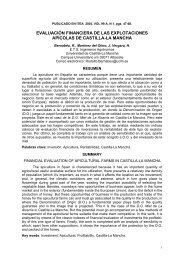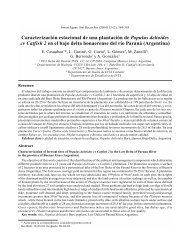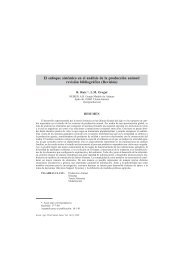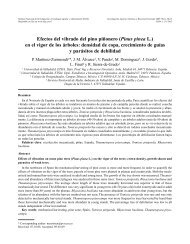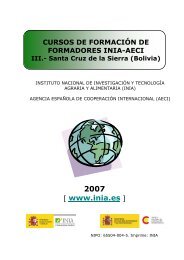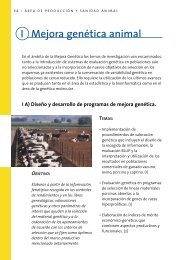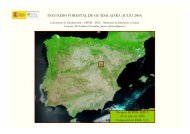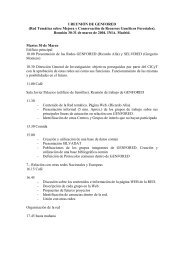Status of medicinal and aromatic plants in - Inia
Status of medicinal and aromatic plants in - Inia
Status of medicinal and aromatic plants in - Inia
Create successful ePaper yourself
Turn your PDF publications into a flip-book with our unique Google optimized e-Paper software.
66<br />
WORKING GROUP ON MEDICINAL AND AROMATIC PLANTS: FIRST MEETING<br />
<strong>plants</strong> have changed: apart from oregano (Origanum vulgare L. subsp. hirtum (L<strong>in</strong>k)<br />
Ietswaart), still abundantly collected <strong>in</strong> central <strong>and</strong> southern Italy, <strong>and</strong> myrtle (Myrtus<br />
communis L.), collected <strong>in</strong> Sard<strong>in</strong>ia to make liqueurs, wild collect<strong>in</strong>g has drastically decreased<br />
because very few people still take part <strong>in</strong> this activity.<br />
Conservation ex situ<br />
It is well known that the earliest attempts to conserve MAPs ex situ date back to the Middle<br />
Ages when the first "Horti sanitatis" were established <strong>in</strong> the monasteries. Afterwards, dur<strong>in</strong>g<br />
the Renaissance the first botanical gardens called "gardens <strong>of</strong> simples" were laid down<br />
accord<strong>in</strong>g to similar patterns (Del Prete et al. 2001). The earliest botanical garden <strong>in</strong> the<br />
world was established <strong>in</strong> Pisa <strong>in</strong> 1543-1544, while a garden connected with the Medicean<br />
court, <strong>in</strong> which MAPs were grown, already existed <strong>in</strong> Florence <strong>in</strong> 1544. While no traces <strong>of</strong><br />
either <strong>of</strong> these gardens rema<strong>in</strong>, the botanical garden <strong>of</strong> Padua, founded <strong>in</strong> 1545, still exists<br />
<strong>and</strong> is tended. Furthermore numerous other universities endowed themselves with similar<br />
<strong>in</strong>stitutions <strong>and</strong> there are currently 38 botanical gardens <strong>in</strong> Italian universities. In addition<br />
there are 31 alp<strong>in</strong>e gardens, <strong>in</strong>clud<strong>in</strong>g 16 located <strong>in</strong> the actual Alp<strong>in</strong>e areas, 15 others <strong>in</strong> the<br />
Apenn<strong>in</strong>es (Sicily <strong>in</strong>cluded) <strong>and</strong> 12 thematic gardens <strong>of</strong> which one is dedicated to MAPs, the<br />
"Giard<strong>in</strong>o delle erbe" <strong>of</strong> Casola Valsenio. Nevertheless, this large number <strong>of</strong> <strong>in</strong>stitutions<br />
does not mean that MAP genetic resources are abundant <strong>and</strong> properly conserved, as <strong>in</strong> most<br />
cases these <strong>in</strong>stitutions have only an educational function.<br />
Activities at a national level to record MAP natural resources<br />
Because <strong>of</strong> the huge environmental variation <strong>in</strong> Italy <strong>and</strong> the restricted economic importance<br />
<strong>of</strong> MAPs <strong>in</strong> our country, it is not feasible to record MAP natural resources at the national<br />
level. In the recent past some studies have been carried out on wild populations <strong>of</strong> oregano<br />
(De Mastro 1996; Leto 1996). More recently, research on the characterization <strong>of</strong> different<br />
wild populations <strong>of</strong> Chamomilla recutita Rausch. collected <strong>in</strong> northern (Aiello et al. 2001) <strong>and</strong><br />
central Italy (Taviani et al. 2002) <strong>and</strong> numerous populations <strong>of</strong> myrtle <strong>and</strong> Rosmar<strong>in</strong>us<br />
<strong>of</strong>fic<strong>in</strong>alis L. collected <strong>in</strong> Sard<strong>in</strong>ia (Mulas 2001) is still underway with<strong>in</strong> the National Project<br />
IPPO ("Increase <strong>of</strong> <strong>medic<strong>in</strong>al</strong> <strong>and</strong> <strong>aromatic</strong> <strong>plants</strong> production").<br />
Accord<strong>in</strong>g to research carried out <strong>in</strong> Trent<strong>in</strong>o (Prosser 2000), <strong>in</strong>volv<strong>in</strong>g 10 years <strong>of</strong> plant<br />
mapp<strong>in</strong>g, 30.6% <strong>of</strong> the species (723 out <strong>of</strong> 2359) are considered as threatened, <strong>in</strong>clud<strong>in</strong>g some<br />
MAP species. For <strong>in</strong>stance, accord<strong>in</strong>g to the categories adopted by IUCN (International<br />
Union for the Conservation <strong>of</strong> Nature): Centaurea cyanus L. <strong>and</strong> Marrubium vulgare L. are<br />
considered critically endangered (CR); Lactuca virosa L. <strong>and</strong> Rosa gallica L., endangered (EN);<br />
Gratiola <strong>of</strong>fic<strong>in</strong>alis L., Hyoscyamus niger L. <strong>and</strong> Hyssopus <strong>of</strong>fic<strong>in</strong>alis L., vulnerable (VU); Althaea<br />
<strong>of</strong>fic<strong>in</strong>alis L., Equisetum pratense Ehrh., Leonorus cardiaca L. <strong>and</strong> Lithospermum <strong>of</strong>fic<strong>in</strong>ale L., at<br />
low risk (LR). Also accord<strong>in</strong>g to this research, the ma<strong>in</strong> factor threaten<strong>in</strong>g the conservation<br />
<strong>of</strong> plant genetic resources (PGR) seems to be the change <strong>in</strong> l<strong>and</strong> use <strong>in</strong> the agricultural <strong>and</strong><br />
pastoral sectors: l<strong>and</strong> ab<strong>and</strong>onment <strong>and</strong> high-<strong>in</strong>put agricultural practices together account<br />
for almost 3/4 (73%) <strong>of</strong> all the threaten<strong>in</strong>g factors identified.<br />
As regards the <strong>in</strong>ventory <strong>of</strong> PGR ex situ, with<strong>in</strong> the project "Cultural Assets", the group<br />
"Botanical <strong>and</strong> historical garden" has been work<strong>in</strong>g for about 4 years to draw up a complete<br />
list <strong>of</strong> the gardens be<strong>in</strong>g <strong>in</strong>cluded <strong>in</strong> this project <strong>and</strong> <strong>of</strong> their correspond<strong>in</strong>g collections (Del<br />
Prete et al. 2001). On a smaller scale, tak<strong>in</strong>g the opportunity <strong>of</strong> this meet<strong>in</strong>g, the authors <strong>of</strong><br />
this paper contacted numerous botanical gardens <strong>and</strong> recorded the list <strong>of</strong> MAPs held by 15<br />
<strong>of</strong> these (Table 5).




